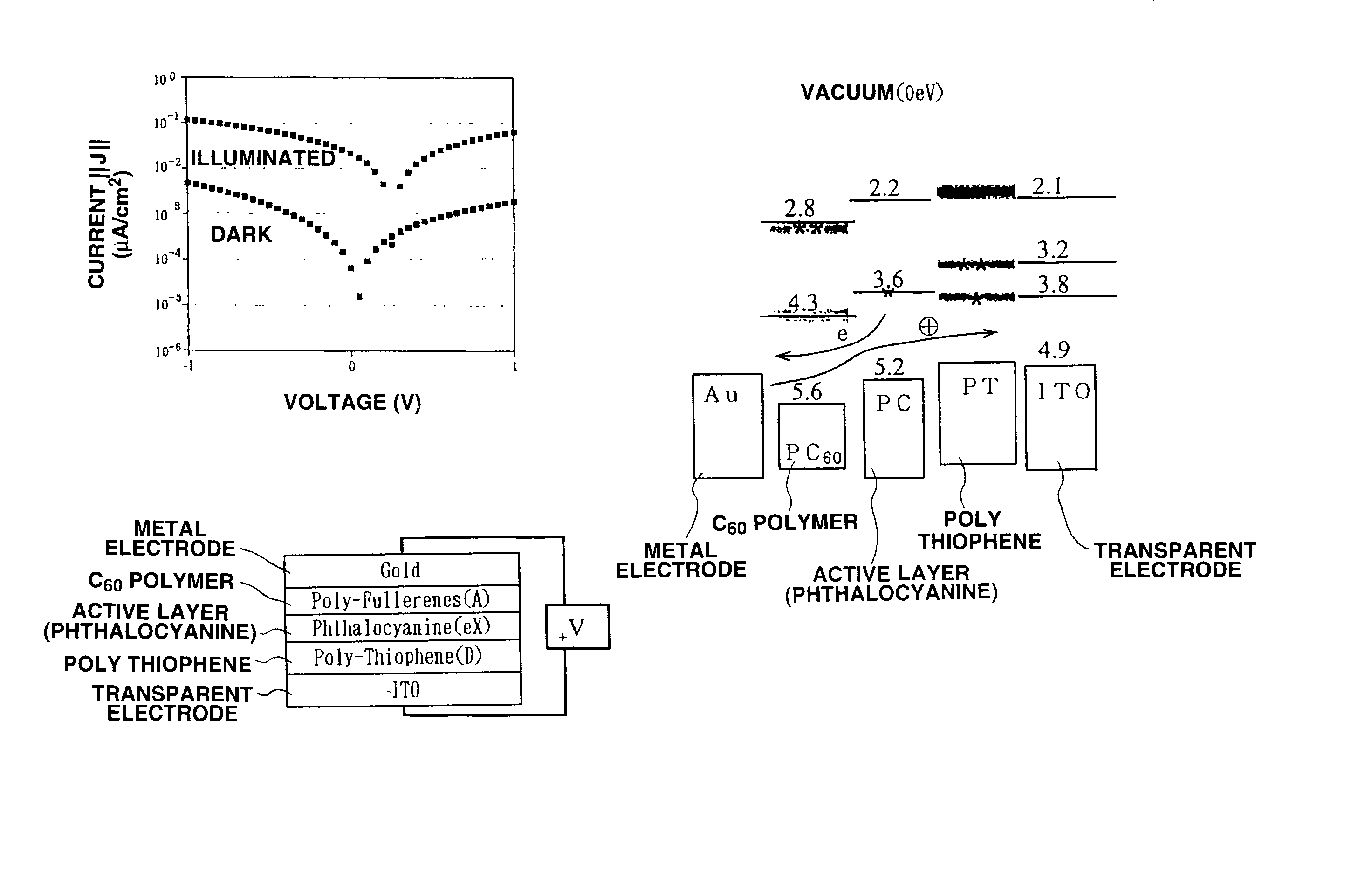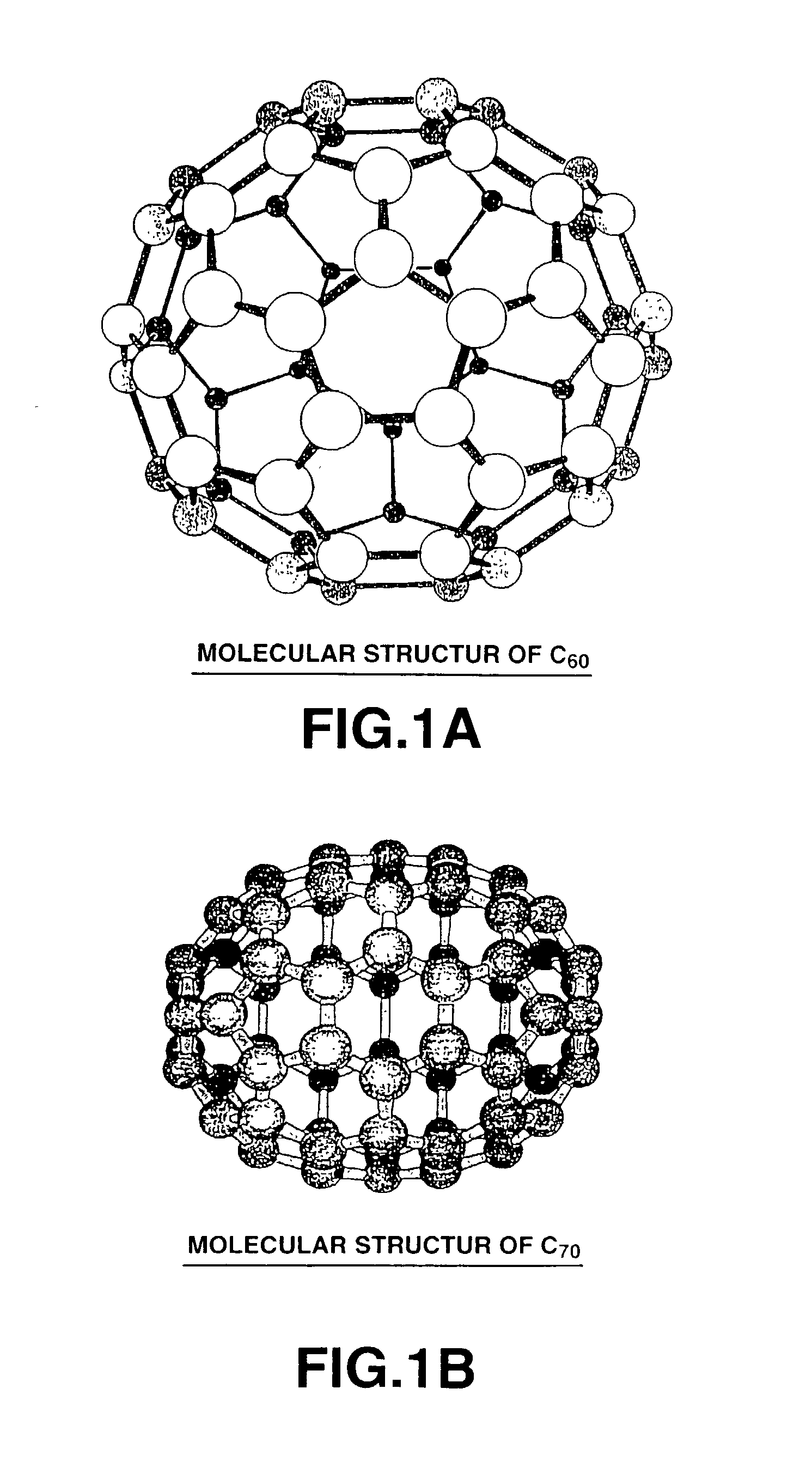Charge separation type heterojunction structure and manufacturing method therefor
a technology of heterojunction structure and manufacturing method, which is applied in the direction of physical/chemical process catalysts, fullerenes, natural mineral layered products, etc., can solve the problems of deterioration in structure, adverse effects of electronic properties, and fragile strength of evaporated films produced therefrom, so as to improve durability and electronic physical properties.
- Summary
- Abstract
- Description
- Claims
- Application Information
AI Technical Summary
Benefits of technology
Problems solved by technology
Method used
Image
Examples
example 2
Formation of Polythiophene Thin Film (Electrically Conductive Organic Film) and Measurement of Physical Properties Thereof)
[0239] On this ITO film was then formed a commercial polythiophene thin film having a sulfur radical as a dopant. The measured results of the PES of this polythiophene thin film are shown in FIG. 45.
[0240] It was seen from the above results that the valence band edge level of the polythiophene thin film exists at 4.82 eV below vacuum.
[0241] Moreover, a polythiophene thin film was also formed on the quartz glass and measurement was made of the current-voltage characteristics thereof. FIG. 46 shows the measured results of the V-I characteristics and absorption coefficients by the light quantum energy.
[0242] A polythiophene thin film was formed on each of an ITO thin film and on a metal film. First, the Fermi level of the ITO and gold was measured by the photoelectron emission method and, based on the measured value, the Fermi level of the polythiophene thin film w...
example 3
Formation of a Fullerene Polymer Film and Measurement of Various Physical Properties
[0244] A fullerene polymer film then was formed on the above-mentioned polythiophene thin film.
[0245] First, fullerene molecules, as a starting material, was prepared in the following manner. In an apparatus shown in FIG. 35, arc discharge was effected by the 150 A direct current in an atmosphere of 100 Torr of helium, using a graphite rod 35 cm in length as a positive electrode. After fullerene was substantially vaporized to produce the fullerene containing soot, the polarities of the two electrodes were reversed and deposited heaped on the inherent negative electrode, such as carbon nanotubes, were further vaporized to produce the soot. The soot heaped in a water-cooled reaction vessel was recovered by a sweeper to produce crude fullerene by extraction with toluene. This crude fullerene was washed with hexane, dried and purified by sublimation in vacuum. The fullerene molecules, thus produced, were...
example 4
Manufacture of Heterojunction Structure and its Physical Properties
[0288] On the above-mentioned layered structure, including a polythiophene film and a C60 polymer film, deposited on an ITO electrode, an aluminum electrode was formed as a counter-electrode in the following manner. First, the inside of a vapor deposition device was evacuated to vacuum of 10.sup.-8 Torr by a turbo-pump and subsequently back-filled with a high purity hydrogen gas. An aluminum film then was formed on the C.sub.60 polymer film of the layered structure in a hydrogen atmosphere of 10.sup.-5 Torr to produce a heterojunction structure.
[0289] From the evaluation of the valence electron band by the photoelectron emission method, Fermi level by the contact potential difference method and the band gap by the optical technique, the band structure of the produced heterojunction structure is as shown in FIG. 55.
[0290] The V-I characteristics of the heterojunction structure were evaluated. The results are shown in ...
PUM
| Property | Measurement | Unit |
|---|---|---|
| band gap | aaaaa | aaaaa |
| electrical resistivity | aaaaa | aaaaa |
| band gap | aaaaa | aaaaa |
Abstract
Description
Claims
Application Information
 Login to View More
Login to View More - R&D
- Intellectual Property
- Life Sciences
- Materials
- Tech Scout
- Unparalleled Data Quality
- Higher Quality Content
- 60% Fewer Hallucinations
Browse by: Latest US Patents, China's latest patents, Technical Efficacy Thesaurus, Application Domain, Technology Topic, Popular Technical Reports.
© 2025 PatSnap. All rights reserved.Legal|Privacy policy|Modern Slavery Act Transparency Statement|Sitemap|About US| Contact US: help@patsnap.com



